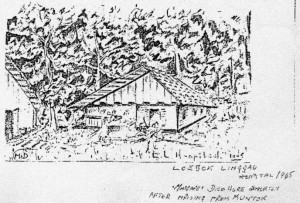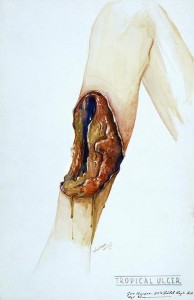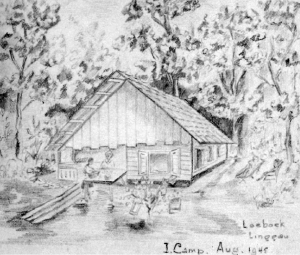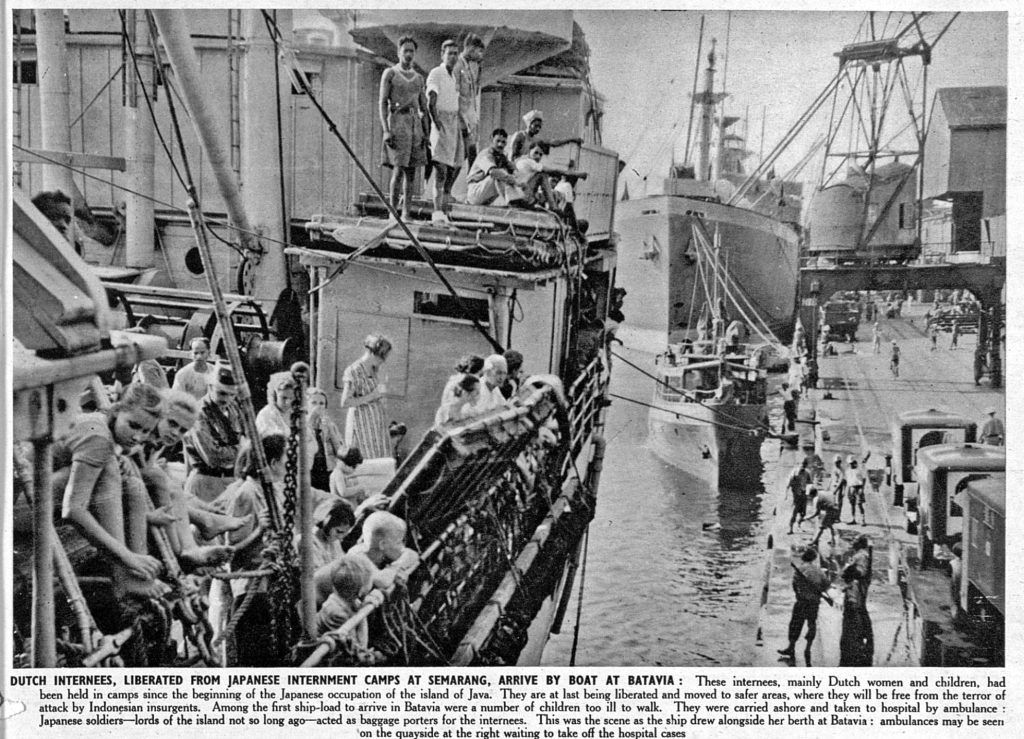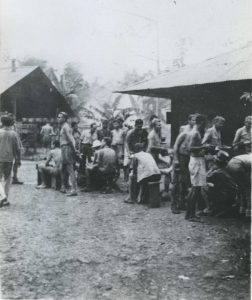Belalau Camps, Loeboek Linggau, Lahat, Sumatra
[The text below is almost entirely based on research undertaken by Judy Balcombe]
When it seemed that life could become no worse, the Japanese moved the captives back across the Bangka Straits through Palembang to their final camp at Loeboek Linggau, near Lahat. The men were moved at the end of February / beginning of March 1945 and the women in April 1945. Some men were too sick to travel and remained in Muntok with a doctor and orderly. These men died in Muntok and did not re-join their friends.
The journey to Palembang was dreadful, lasting a day and two nights in cramped and stifling conditions. The men left the jail at Muntok at mid-day on 26 February and they were placed in the hold below deck of a small cargo steamer. There they were forced to stand with very little air to breathe and the conditions became unbearably stifling. Eventually at 6.00AM the following day, having stood all night, the ship slowly moved away from Banka Island. The prisoners had no idea where they were being taken until they began heading back up the Moesi River toward Palembang where they arrived at 6.00PM the same evening, still standing.
Next the women were moved. The journey was described later by some of the AANS nurses. As usual they travelled in the remnants of their uniforms and Red Cross armbands in case anyone perchance saw them. The Japanese insisted that the second of the three contingents to leave the Muntok camp should be the hospital staff and patients, some of whom were gravely ill and had only a few hours to live.
Those nurses who could, carried the stretcher cases onto the waiting boat, despite the presences of dozens of Japanese soldiers who watched with “horrified” faces but made no move to assist.
Nursing sister James described the journey: “It was the same frightful boat on which we had come over previously. The hospital staff and the patients were put on the deck without any covering from the sun at all. The remainder of the people were put in the hold, which was even worse. The crowding on the ship was completely disgraceful. There were no sanitary arrangements at all. At the time people were suffering severely from diarrhea — practically everybody that had been in camp.”
A Dutch woman died woman on the pier and an Englishwoman was buried at sea. Jeffrey wrote, “That burial was a nightmare.” Once they were at Palembang they were loaded onto trains and the stretcher cases into cattle trucks. Several died before they had even left the station. James continues: “We remained that night at Palembang with all the shutters down, in the stifling heat, and sanitary conditions ghastly. [There were no lavatories and excreta could only be ejected out of a sliding hatch high in the walls.] Next day we set off and were allowed between stations to have the shutters up a few inches. The odour of sweating humanity became terrible . . . We arrived at Loebok Linggau having lost several more patients on the way. These . . . were left for several hours dead in the vans. Some were carried more or less strung under the train.”
[One question remains – where were those who died on the journey buried?]
As Jeffery noted, at Palembang the internees were placed into closed railway trucks. The compartments were so small and the internees squeezed in so tightly that they were forced to sit upright and in this fashion they were taken after a twelve hour journey to their final camps at Loeboek Linggau.
The men and women were placed in separate camps at Belalau, an abandoned rubber plantation near Loeboek Linggau. They did not know that the others were nearby and had no contact with them; they were not even told when a husband or wife lay dying.
Accommodation was in dirty, old, rat-infested huts which formerly housed the estate workers. A stream ran through the camps, providing drinking and washing water although this soon became contaminated through bathing and effluent. There was very little food and the sickness and death rates were very high.
The nurses, themselves weak and very frail, worked hard to help their fellow women and children. In reality, there was little they could do apart from give patients a cool wash, try to encourage them to drink, and to swallow a few grains of rice. Records show that 99 men and 89 women died and were buried at Belalau.
John (Jock) Brodie wrote in his recollections of the camp that:
Black water fever showed its appearance in this camp and Cerebral malaria was a most extraordinary trouble. It seemed always to attack the strongest men in the camp and in less than a week they were gone. Tropical ulcers were awful to look at, and the vile odour from the open sore required a stout heart and strong stomach. The dressing staff had some very dangerous work to do attending to such patients.
At Belalau we lost about 122 of our number in the five months and up to the time of our liberation. This was over 25% of our total number in the camp at Belalau. Really we were getting near the end of resistance, and had the Atom Bomb not hastened Victory, many more of our fellows would have perished. Over the whole period 109 British. died out of a total of 196 [the rest being mainly Dutch] which is 55.60% an exceedingly high percentage and represents the real truth of Jap methods and treatment.
One male internee was Dr Albert McKern, a family doctor and obstetrician from Penang. Suffering from amoebic dysentery at Belalau, he realised he was near death and asked to make an amendment to his will. In the document, he asked that all his assets be realised in the future when his wife and children had all died and a further number of years had passed. Dr McKern wished that all of the funds then be divided equally among his three universities of Sydney, Edinburgh and Yale, to be used for obstetric research. In due course, this did occur and $12 AUS million was distributed – a wonderful legacy from a man thinking of others while in his own hopeless plight.
Belalau camps were guarded but surrounded by barbed wire. A few internees risked the patrolling guards to slip under the wire and through a drain to get out and forage for food. Ubi kayu or tapioca root tubers, growing wild or taken from farmers’ fields, could be wrenched from the ground and smuggled back to camp, to be eaten or sold to others. The penalty if caught outside the camp was extreme – one man found outside the wire was taken away by the guards and not seen by his friends again.

When food supplies were critical, one internee, a game hunter, was permitted to hunt for wild boar. He was given a rifle and, heavily guarded by the Japanese, was permitted to seek wild animals to supplement his fellow prisoners’ rations.
Liberation 1945
Life and death continued in this fashion until 24th August 1945. Captain Seki Kazuo called the men and the women together in their camps. The internees thought Captain Seki was gathering them together to kill them all, but instead he stood on a table and addressed them. ‘The War is over’, he said. ‘Now we can be friends’. He did not announce who had won the War.
In 1948, a War Crimes Tribunal in Medan sentenced Captain Saiki (Seki) Kazue to 15 years imprisonment for harsh treatment of the internees. General Moritake Tanabe, the officer in charge of Sumatra, was sentenced to death. He denied ever having visited the internment camps.
The new and powerful atomic bombs had been dropped on Hiroshima and Nagasaki on August 6th and 9th 1945 and Japan’s Emperor Hirohito had broadcast Japan’s surrender on radio on August 15th. The internees did not learn of the surrender until 9 days later and were then not released for many weeks.
Belalau Men’s and Women’s camps were among the very last to be liberated in Sumatra. The Japanese had denied their existence, fearing repercussions when the skeletal internees were found and the high death rate was known. Major Tebbutt, who had been in Muntok jail in February 1942 and who had been told of the massacre at Radji Beach before being sent to Changi POW Camp in Singapore, had reported the existence of the group of Australian nurses. After repeated questioning, the Japanese eventually revealed there were further captives held at the abandoned rubber estate of Belalau, at Loeboek Linggau, near Lahat.
On September 5th and 7th 1945, Allied paratroopers Major G. F. Jacobs and Sergeant–Major C.B. Hakkenberg entered Belalau Men’s and Women’s camps. They had been parachuted into Sumatra to locate groups of internees and ensure the Japanese camp commandants did not kill the captives or conceal their existence.
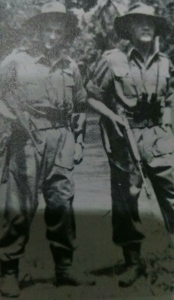
Jacobs and Hakkenberg informed the Allied authorities and soon, food and newspapers were dropped into the camps and plans made to remove the internees to Singapore. Their work in helping to liberate internees from the many Sumatran camps is told in Gideon Jacobs’ book, Prelude to the Monsoon.
The delays proved fatal for some, including BBC radio broadcaster Andrew Carruthers, who died on 9th September 1945 while still in camp. He was able to be visited by his wife Marguerite, who had been interned in the Women’s Camp but very ill and without proper hospital care, he worsened and passed away.
Other internees only learnt of their families’ deaths when seeking them in the Men’s or Women’s camps. When one boy visited the Women’s Camp and asked his little nephew where his own Mother and two adult sisters were, he learnt they had all died.
The internees were suddenly provided with Red Cross food parcels which had been hoarded in Camp for years by the Japanese. Clothing, mosquito nets and medicines materialised from the Japanese stores.
Captain Annie Sage of the Royal Australian Nursing Service flew from Australia to Lahat to meet her nurses. On seeing the depleted group in such a weakened condition, she asked where the other nurses were – ‘This is all’, she was told.
On September 17th, an aeroplane left Lahat for Singapore, carrying the 24 surviving Australian nurses and 36 of the sickest women to hospital. The other internees were evacuated later and Belalau camps were emptied by October 8th. The internees had suffered 3 years and 8 months of unbelievable hardship and over 500 of their fellows had died.
The survivors were taken to hospital and fed slowly and cautiously so their bodies could become used to food again. Eating too much too quickly could disturb the body’s chemistry and even be fatal.
A LIST OF THOSE WHO DIED AT BELALAU
(this list is “under construction”)
Many of those who were buried at Belalau were re-interred by the Dutch after the war at the following three cemeteries. .
For some individuals, we have so far been unable to locate where they were re-interred but we keep on looking.
ANDREWS, G. V. [George Vincent] Died 27.5.45 [38] Belalau. If he was reinterred, we are unable to locate where.
ALBERT, I. B. Died 3.6.45 [64] Belalau. Reinterred at Leuwigajah. Grave V 1087.
ALLEN, W. P. [ William Probyn], died 25.3.45 [33] Belalau. Reinterred at Leuwigajah. Grave V 510.
CARRUTHERS, A. [Andrew] Died 1.9.45 [59] Belalau. If he was reinterred, we are unable to locate where.
DAVIS Ms Winnie May Died 19.7.45 [30]. Grave moved to Jakarta, Commonwealth War Graves.
DRYBURGH, Ms Margaret Died 21.4.45 [55] Belalau. Reinterred at Kalibanteng. V-III 194.
ELSTON, R. [Reginald] Died 17.5.45 Belalau. If he was reinterred, we are unable to locate where.
FOULDS, H. H. Died 7.6 .45. Belalau. Reinterred at Pandu. Grave IV 257.
FREEMAN Ms Rubina Dorothy Died 8.8.45 [32] Belalau. She was re-interred in the Commonwealth War Graves, Jakarta.
GARDNER Mrs. Gertrude Felicia. Died 5.6.45 [49] Belalau. Reinterred at Kalibanteng. Grave V-III 149.
GASPER, M. C. Died 24.7.1945 [61] Belalau. Reinterred at Pandu. Grave IV 51.
HASTINGS Mrs Olga Lillian. Died 1.7.45 [50] at Belalau. Reinterred at Kalibanteng. GraveV-III 159.
HILTON Mrs. Maude Florence Died 28.4.45 [53] Belalau. Reinterred at Kalibanteng. Grave V-III 162.
HUGHES Ms. Gladys. Died 31.3.1945 [36] Belalau. She was re-interred in the Commonwealth War Graves, Jakarta.
INGLIS, G. S. [George Sutherland] Died 13.3.45 [50] Belalau. Reinterred at Pandu.Grave IV 46.
JACKSON, J. W. [John William] Died 2.9.45 [45] Belalau. Reinterred at Pandu. Grave IV 48.
JENKIN, Mrs Mary Lyndon Died 16.8.45 [49] at Belalau – CWGC. Cross list shows “…died on 17.9.45…” Reinterred at Kalibanteng. GraveV-III 23.
KENDALL, H. P. [Horace Paul] Died 15.5.45 [59] Belalau. If he was reinterred, we are unable to locate where.
LIVINGSTONE, Anne Armstrong, Died 18.7.45. Reinterred at Kalibanteng, Grave V-III 193.
LONGLAND, H. A. [Harold Albert] Died 24.8.45 [57] Belalau. If he was reinterred, we are unable to locate where.
MADDEN Mrs Evelyne Frances. Died 22.4.45 [?] Belalau. Reinterred at Kalibanteng. Grave at V-III 152.
MacFIE-ABRAHAMS Mrs Rennie died 14.6.45 [50]. Mrs Cross list shows date of death as 10.5.45 Belalau. Reinterred at Kalibanteng. Grave V-III 152.
McKERN Dr A. S. Died 16.6.45 [62] Belalau. If he was reinterred, we are unable to locate where.
MITTELHEUSER, Ms. Pearl Beatrice Died 18.8.45 [41] Belalau. She was re-interred in the Commonwealth War Graves, Jakarta.
MOUNTAIN, S. A. [Stanley Arthur] Died 26.3.45 [ ] Belalau. Reinterred at Jakarta.
PATON, T. H. K. [Thomas Haldane Kerr] Died 23.4.45 [26] Belalau. Reinterred at Pandu. Grave IV 63.
PETERKIN, W. D. [William Dennis] Died 15.4.45 [42] Belalau. Reinterred at Pandu. Grave IV 62.
PHILLIPS, M. L. [Maurice Louis] Died 5.7.45 [60] Belalau of beri beri. Reinterred Kalibanteng. Grave IV 250.
RAYMOND, M. E. Died 13.5.45 [54] Belalau. Reinterred at Leuwigajah
SINCLAIR, D. [Douglas] Died 16.4.45 [52] Belalau. Reinterred at Pandu. Grave IV 69 (Pandu site says 17.4.45).
SINNATT, Anthony Died on 17.4.1945 at Belalau aged 7 years. After the war Anthony was re-interred at Kalibanteng. His grave can be viewed HERE.
STAPLEDON, C. E. C. [Charles Edric Cooper]. Died 16.8.45 [45] Belalau. If he was reinterred, we are unable to locate where.
STEVENS Mrs Edith Christie. Died 22.6.45 [65] Belalau. Reinterred at Kalibanteng. Grave V-III 145.
STEVENS, Douglas. Died 17.4.45 [age ?]. If he was reinterred, we are unable to locate where.
THANE, Mrs Phyllis. Died 20.4.45 [52]. She was reinterred at Kalibanteng. Grave V-III 174.
TUNN, Mrs Doris Lilian. Died 15.6.45 [50] Belalau. She was reinterred at Kalibanteng. Grave V-III 166.
VAN BUREN, Henry James. Died in captivity 23.3.45 [66] at Belalau. His body was later reinterred at Pandu te Bandung. Grave IV 237.
VAN GEYZEL, Mrs Florence. Died 15.7.45 Belalau. She was reinterred at Kalibanteng. Grave V-III 157.
WATTERS-PRYCE Mrs Grace Anna Died 13.4.45 [28] Belalau. She was reinterred at Kalibanteng. Grave V-III 154.
WATTS-CARTER, Millicent Died 27.8.45 [34] Belalau. The last woman captive to die. Mrs Cross list shows date of death as 29.8.45. She was reinterred at Kalibanteng. Grave V-III 168.
WEIR, Mrs Agnes. Died 14.7.45 [39] Belalau. She was reinterred at Kalibanteng. Grave V-III 168.
Problem of the Prisoner of War when he is Home
The psychological effect of internment was not always well-understood. A doctor caring for the Nurses in Singapore remarked: “They will go home as soon as we have fattened them up. A week will make a lot of difference. In a fortnight they will be themselves again.”
Some efforts were made to understand the stress and trauma which POWs and internees had undergone. Caroline Isaacson wrote in the Melbourne Argus, 28 August 1945:
IT IS THE AFTERMATH OF WAR that often brings even greater problems than war itself and the problem now uppermost in my mind is that of the returned prisoner of war. Ever since our men were taken captive many of us have shared their exile in our thoughts and in our hearts, but none of us at home could possibly have realised to the full all that they have had to endure.
I know several returned POWs, and all are reluctant to speak of their experiences. It is not difficult, however, to piece together, from the little they will say, that cruelties and indignities of many years have left scars as deep in their minds as in their bodies.
It is essential to keep that in mind, especially when the first excitement of his return home has passed, and it is important to remember that a man who has been a prisoner for a considerable time will be inclined to feel himself a stranger, not only in his home town, but in his family circle.
Some internees did manage to put the past behind them and resume their lives. A number returned to their occupations in Malaya while others settled in Australia, England, Holland and South Africa. Others suffered what would be now recognised as Post Traumatic Stress Syndrome, with nightmares, anxiety and depression.
Many survivors report that they never spoke of their experiences, even when meeting fellow internees after the War. Some children were told by their parents to put the past behind them and not think about it, as it could not be changed.
The surviving Nurses returned home, to work or family life. Their story preceded them, with a torrent of newspaper articles describing the massacre at Radji beach and their subsequent years of deprivation. Many families were still unaware of their loved ones’ fate and must have thought the worst on reading about the Nurses.
Above is taken (with permission) from Judy Balcombe’s FULL CIRCLE: From Memory to Hope.
Below is taken from: The Tasmanian Times: 25 April 2012
An Anzac Story – Finding the Nurses in Sumatra
Finding the last group of civilian internees in Sumatra was a result of the amazing efforts of a British officer who was parachuted into Sumatra with a team of four men just before the war ended.
Major Gideon Jacobs’ team of four consisted of two Australians, one Dutchman and one Chinese Javanese, and they jumped from their Catalina flying boat transport into Japanese occupied territory about 100 kilometres from Medang with orders to gather intelligence and radio information back to SEAC headquarters (Mountbatten’s south-east Asian command). Several days later they were ordered (by radio) to make contact with Japanese military authorities in Medang and demand assistance in their mission. This they did, but most significantly, Jacobs was immediately contacted by several European civilians, former internees, who briefed him on the dire conditions in POW camps throughout Sumatra. Jacobs immediately ordered the Japanese to take him to all POW camps in Sumatra, far and wide, while also arranging for evidence to be collected wherever he went about Japanese atrocities. When he was in Palembang at the beginning of September, one of the investigations he had set in train provided information from a number of different sources that Australian nurses had been in a camp there but had been moved to another location. Jacobs then realised that the Japanese had kept information from him about the location of the nurses. They deliberately kept secret the existence of the camp at Belalau rubber plantation, about 15 kilometres from the small town of Lubuklinggau, because they wanted to try to improve the physical condition of the nurses before they were found.
This is how it was done. On 19 August, four days after the Japanese emperor ordered Japanese forces throughout the conquered territories to lay down their arms, the nurses were visited in their camp by a “high Japanese official”. Soon after this, when the Japanese ordered that children in the camp whose mothers had died but whose fathers were interned in another camp be moved permanently to be with their fathers, Jessie Simons commented: “As some of the children were by now quite young women the order was rather more strange than usual, even by Jap standards. It looked as though something big was in the air…”. On 23 August, which happened to be Simons’ 34th birthday, “we were … told that an important announcement would be made the next day”. So it was that on 24 August the nurses were told by the brutal Japanese commandant, Captain Saki: “Now there is peace, and we will all soon be leaving Sumatra. If we have made any mistakes in the past we hope you will forgive us, and now we can be friends”. Saki then allowed “some vegetables for us, and boxes and boxes of medical stores, bandages, quinine, vitamin tablets, serums, powdered milk, butter etc”. During the following week the camp kitchens were stocked with plentiful supplies of rice and carrots, and freed men from a nearby camp brought in fresh meat and fruit, and then took over looking after the women. On 29 August Betty Jeffrey wrote that “today we all had half a cup of milk, the first for years. We are getting bacon and papaya each day. It is a wonderful feeling not to be ravenously hungry all day long”. In the first week of September Jeffrey recorded in her diary: “Things are coming in each day now. They have apparently been here for ages – things we have asked for over and over again, medicines we begged for and were refused, so our women died. To think they had so much stuff so close to our camp…”.
It was during this time that Major Jacobs was finally told by the Japanese about the camp. He immediately flew to Lahat with his team, drove to Lubuklinggau, where the two Australian radio operators established a base to communicate with Ceylon, and the other three men went to Belalau. “The Allies have arrived!”, wrote Betty Jeffrey on 7 September. “Two very young Dutch soldiers and a Chinese military man arrived today”. Jacobs had arrived in mid-afternoon, and only had time to register his shock at what he considered the worst camp he had visited in Sumatra, before returning to Lubuklinggau to prepare for a more thorough investigation. He returned on 9 September, and it was on this day that he discovered that some of the European women in the camp were the missing Australian nurses. After forcing the Japanese to identify all their local storehouses and open them for the camp to use, Jacobs hurried back to Lubuklinggau once more, to report the news to Colombo. The message his two Australian radio operators sent was the first real news that the outside world heard of the location of the Vyner Brooke nurses since they left Singapore in February 1942:
“Have encountered among 250 repeat 250 British female internees in LoebukLinggau camp Sister Nesta James and 23 other surviving members of the Australian Army Nursing Services remnants of contingent AANS evacuated from Malaya in Vyner Brooke stop In view of their precarious health suggest you endeavour arrange air transport direct to Australia from here soonest stop Am collecting particulars massacre of members AANS on Bangka Island for later transmission”.
On 11 September Jacobs and the two Australians (only identified as Sergeant Bates and Sergeant Gillam) returned to the camp, causing great excitement among the nurses. Vivian Bullwinkel was the first to see the Australian military badges and rushed to tell the others that “Australians are here!”. According to Betty Jeffrey it was “these two boys” who told them about them about the atom bombs dropped on Hiroshima and Nagasaki, and that they could no longer hold any reservations about the war having been ended and having been won. They were free at last. But the nurses had no idea of the shock that their physical appearance gave to the two Australians. Gillam became so enraged at how they had been treated by the Japanese that he lined all the guards up along the barbed wire fence of the camp, and it took some careful persuasion by Jacobs that the Japanese would face prosecution for their crimes before Gillam decided not to shoot them.
Once the news about the nurses became known, planes based at Cocos Island flew low over their camp and the nearby Men’s camp and dropped food parcels. On 14 September the nurses ate bread baked on Cocos Island the day before, “half a slice each with butter and Vegemite, and it was like sponge cake”.
The next day, while Colonel Annie Sage and Captain Jean Floyd were on their way to Palembang by air, the nurses were “plucking ducks and fowls in preparation for (a birthday party for one of the internees, not a nurse), we were interrupted by a message that the AANS and sick internees were to prepare for immediate evacuation. Feathers flew everywhere”, wrote Jessie Simons.
At 4 am the next morning, a group of 60 women, including the 24 Australian nurses, departed in trucks while it was raining, and it took three hours to travel to Lubuklinggau, because one of the Japanese drivers “saw to it that his truck broke down every half mile”. The accounts by Jessie Simons and Betty Jeffrey of their journey from Belalau prison camp to the airstrip at Lahat are among the most vivid and detailed descriptions of any of their experiences, demonstrating the sheer impact of what was happening to them. At Lubuklinggau they were met by an Australian air force pilot and an Australian war correspondent, Haydon Lennard, who had been trying to find the nurses since the end of the war, and who finally made contact with Major Jacobs and his team. The nurses were now told that two planes were on their way from Singapore to Lahat to collect them, and that a train had been organised to take them the 90 mile journey from Lubuklinggau to Lahat. When they arrived at Lahat at midday on 16 September they were told that only one plane would be coming from Singapore, and that 30 of the 60 women would have to wait for one more day before being evacuated, but it was decided that all the Australian nurses would fly out on the first plane.
Jessie Simons described the unforgettable moments in the lives of the nurses when the plane arrived at Lahat:
“Someone heard a drone, another scoffed, and we all paused to listen and scan the sky for the approaching plane. At last the bright afternoon sun flashed its signal from the big silver wings of a Douglas transport as it circled the strip and swung in to land among the palms. Our suspense had been justified by the arrival of only one plane and, as we watched it roll towards us, we felt a passing regret for the party which would have to stay at least another night in Sumatra.
The Douglas had barely stopped before a door was swung open and a tall, slim Australian, Major Windsor of the 2/14th AGH, jumped down and raced towards us, followed a little more sedately by three nurses in tropical kit and slacks. Only when Major Windsor called, “Which are the Australian nurses”, did we realise how unrecognisable the remains of our old grey uniforms had become. When the first confusion had passed, one of us asked the senior nurse, “Who are you?” She replied, “I am the mother of you all.” It was Matron Sage, Matron-in-Chief of the AANS. With her were Sister Chandler of the RAAF and Sister Floyd, one of the original staff of the 2/10th AGH to which some of the girls had belonged. Running an eye over the group Matron Sage enquired, “Why, where are the the rest of you? Weren’t there thirty two nurses in the party?” Our silence gave the answer before we found words to tell of the eight over whose graves in Muntock or LoeboekLinggau we had erected those rough crosses.” Sage and Floyd then went to the hospital at Lahat to stay with the others women who would be evacuated from Sumatra the next day.
As they flew out, Jessie Simons “caught a fleeting view of Irenelaan”, the site of the horrific camp they were incarcerated in at Palembang, and then later, in the fading light, the nurses tried “to identify Singapore landmarks from the unfamiliar height of 2,000 feet. Below we would see rubbish and ruins, legacy of the bombardment we so well remembered, but there would be no sudden spurts of smoke and debris, no heavy pouring smoke from burning oil. All that was over”. The nurses landed in Singapore “with feelings which cannot be recaptured or repeated, but soon we were overwhelmed by the welcome waiting for us….”.
This is an edited extract from a forthcoming book about Tasmanian military nurses during the Second World War.
See more at: http://www.tasmaniantimes.com.au/index.php/article/an-anzac-story-finding-the-nurses-in-sumatra#sthash.2kNLMRAl.dpuf


